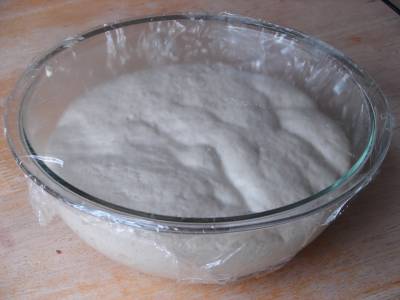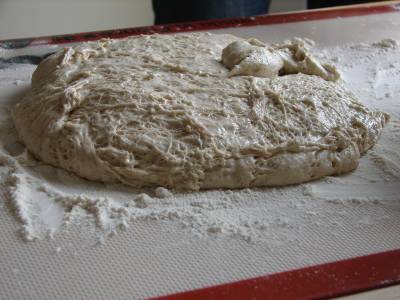Servings: 10
Total Cost: $0.59
Cost Per Serving: $0.06
Total Calories: 1,075
Calories/Serving: 108 |
This pugliese, is an adaptation on Rose Levy Beranbaum’s “Brinna’s Pugliese” from her book “The Bread Bible” and it turned out quite nice. The small amount of rye in the recipe gave it wonderful underlying hint and flavor, do not leave it out! This bread has a nice, earthy flavor without being too dense or heavy. A perfect bread to either have on the side with cheese, with soup or just with olive oil. This makes a very wet dough so it’s best to use a mixer. Makes one bread (feel free to double the recipe to make two breads) Dough Starter – Biga
1/8 teaspoon instant yeast
3 fluid ounces water, room temperature
½ cup all purpose flour
1/3 cup dark rye flour
¼ teaspoon salt
Dough
¾ cups water, room temperature
1 ½ cup plus 1 ½ tablespoons all purpose flour
¾ teaspoons instant yeast
dough starter (about ¾ cup)
¾ teaspoon salt
Method:
1. Make the biga by mixing together yeast, water, all purpose flour, rye flour and salt in a small bowl. Stir with a wooden spoon for about 3 minutes until it is very smooth. Cover with oiled plastic wrap and let sit in room temperature for about 6 hours until it has doubled and filled with bubbled. Now you can either use it right away, or refrigerate it up to 3 days. away, or refrigerate it up to 3 days.
2. Make the dough by combining water, all purpose flour, yeast and the dough starter. Using a mixer, mix on low speed for about a minute until the floured is moistened. Cover the bowl with plastic wrap and let sit for 20 minutes. Now, sprinkle the salt on the dough and knead it on medium speed for about 7 minutes – it will be quite sticky. Scrape the dough into an oiled bowl, cover with oiled plastic wrap and let rise until doubled, about 1 ½ hours, ideally in 75 – 80 degrees. (If your kitchen is colder than that, you can put your oven on warm for a minute, then shut it off and leave the dough inside the oven for the rising period).
3. Scrape the dough out onto a floured surface (it will be very sticky) and round it into a ball. Try not to dust it with too much flour in order to keep it from sticking, and try to keep as much air inside the dough as possible. Either set the dough ball into an 8 inch banneton (or use a colander with a floured towel) bottom side up, or just put the ball directly on parchment paper, either on a baker's peel or sheet pan. Cover the dough with oiled plastic wrap and let rise until almost doubled, about 1 hour.
4. Preheat the oven to 450 degrees at least 30 minutes before baking. On the lowest shelf in the oven, place a cast-iron pan or a sheet pan. Above, place a baking stone or a sheet pan.
5. Remove the plastic wrap and carefully invert the dough onto a lined baking sheet, alternatively use the bakers peel and place the dough on parchment directly on the stone. Slash the bread with a serrated knife a couple of times before putting in the oven.
6. Now bake, place the dough in the oven. Toss ½ cup of ice cubes into the pan beneath and shut the door immediately. Bake for 15 minutes, then lower the temperature to 400 degrees and continue baking for 15 minutes or until an instant read thermometer in the center reads about 204 degrees. 7. Let cool on a cooling rack.
|

